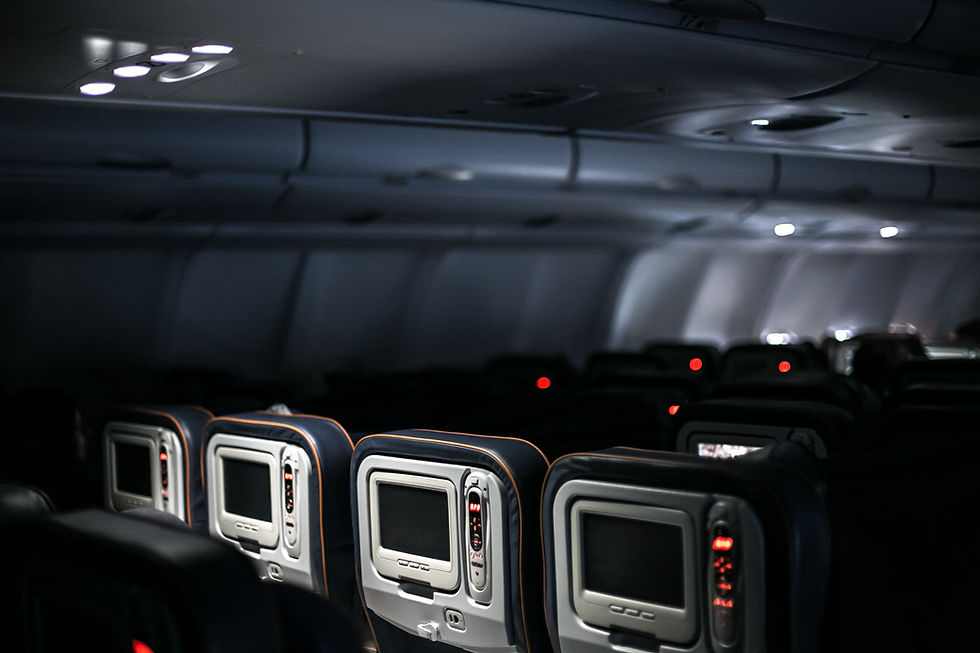Airplane Ear: What Causes It and How to Find Relief
Updated: Dec 16, 2024
There’s nothing quite like the excitement of landing after a long flight and finally reaching your destination. But for many people, that excitement is often interrupted by uncomfortable ear pain that lingers even after they’re back on solid ground. Post-flight ear pain is common and can happen to anyone. In this post, we’ll cover why post-flight ear pain happens, how to prevent it, and how to tips for easing the pain.

Why Does Ear Pain Happen After a Flight?
The culprit behind post-flight ear pain, or "airplane ear", is often ear barotrauma. This happens when the pressure inside the ear doesn’t equalize with the pressure outside, especially during descent, causing a feeling of fullness, discomfort, or pain.
This pressure mismatch occurs because the Eustachian tubes—the tiny passageways that connect your middle ear to the back of your throat—can’t adjust fast enough to the quick change in altitude.
Normally, the tubes open and close to keep the pressure balanced, but things like congestion from a cold, allergies, or sinus issues can prevent them from working properly, leading to that familiar ache.
Common Symptoms of Post-Flight Ear Pain
Post-flight ear pain can vary from mild discomfort to sharp, intense pain. Here are some symptoms you might experience:
Fullness or pressure in the ears
Dull or muffled hearing
Sharp pain or earache
Popping or clicking sounds
Dizziness, vertigo, or slight imbalance
If these symptoms persist, it may mean that your Eustachian tubes are still having trouble equalizing pressure, and your ears need some extra help recovering.
Understanding Risk Factors for Airplane Ear
Certain conditions make some individuals more susceptible to airplane ear. In a systematic review, it was determined that an estimated that 10% of adults and 22% of children might have changes to the ear drum after a flight.
Small eustachian tubes, especially in infants and toddlers, can make it harder for their ears to adjust. Similarly, conditions like the common cold, sinus infections, allergic rhinitis, or otitis media can obstruct the eustachian tubes, trapping pressure.
Even napping during a flight, particularly during takeoff or landing, reduces the natural swallowing and yawning actions that help equalize pressure in the middle ear. In severe cases, unrelieved pressure can permanently affect the delicate membranes of the eustachian tube or middle ear, worsening the condition over time.
Preventing Airplane Ear: Tips for Easing Ear Pressure
Primary Prevention
Yawning, Chewing, and Swallowing: Engaging these actions during takeoff and landing helps activate the muscles that open the eustachian tubes, equalizing pressure in both ears. Chewing gum or frequently swallowing can be particularly effective for pressure relief.
Avoid Sleeping During Ascent and Descent: Staying awake during these critical periods allows you to monitor ear discomfort and use pressure-relief techniques when needed. Sleeping can reduce these natural actions, making you more susceptible to discomfort.
Reschedule Travel if Sick: When suffering from a cold, sinusitis, nasal congestion, or a recent ear infection or surgery, consider postponing air travel. These conditions can block the eustachian tubes, making pressure changes more painful and difficult to manage.
Use Earplugs: Special earplugs designed for flying can help gradually equalize pressure changes during ascent and descent, offering some protection to the eardrums.
Take Decongestants Before Flying: Using a decongestant 30 minutes to an hour before takeoff can help relieve nasal congestion, allowing the eustachian tubes to stay open and relieve pressure more easily.

Secondary Prevention or Relief
Valsalva Maneuver: This maneuver helps equalize ear pressure when discomfort occurs mid-flight. To perform it, close your mouth, pinch your nose, and gently exhale as if blowing up a balloon. This controlled pressure can help open the eustachian tubes by engaging muscles that elevate the soft palate, relieving pressure buildup in the middle ear.
Handling Ear Bleeding: In the rare case of ear bleeding due to pressure changes, stop the bleeding by gently packing the ear with cotton balls until you can seek medical attention. Aside from pressure to the eardrum, this can be due to perforation of the tympanic membrane.
If the bleeding persists, an evaluation by an otolaryngologist is advised.
Find the Ear Care You Need in Hollywood, FL
If symptoms persist or worsen, don’t hesitate to visit a healthcare professional to ensure proper care. Our team at ENT Family is equipped and able to diagnose and treat a variety of ear conditions.
Address: 3911 Hollywood Blvd#201, Hollywood, FL 33021, United States
Phone: 754-888-1368
Email: info@entfamily.com
REFERENCES
[1] Bhattacharya S, Singh A, Marzo RR. "Airplane ear"-A neglected yet preventable problem. AIMS Public Health. 2019 Aug 26;6(3):320-325. doi: 10.3934/publichealth.2019.3.320. PMID: 31637280; PMCID: PMC6779601.
[2] Wright T. Middle-ear pain and trauma during air travel. BMJ Clin Evid. 2015 Jan 19;2015:0501. PMID: 25599243; PMCID: PMC4298289.
[3] Mayo Foundation for Medical Education and Research. (n.d.-a). Airplane Ear. Mayo Clinic. https://www.mayoclinic.org/diseases-conditions/airplane-ear/symptoms-causes/syc-20351701

.png)
Comments